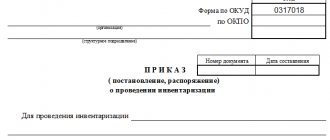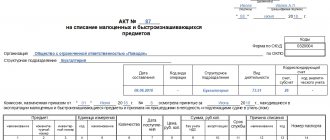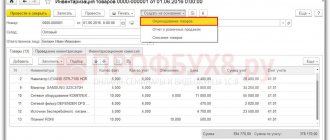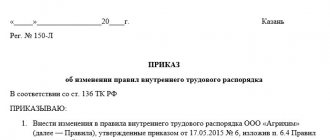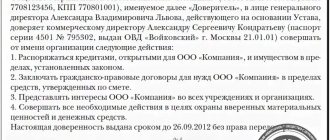Why and when is verification needed?
Any organization conducts an inventory of material assets at least once a year. For this purpose, a special commission is appointed from among authorized employees and an order is issued to conduct an inventory.
The order to begin an inspection is issued by the head of the organization on a scheduled or unscheduled basis. The person responsible for such an event is usually the chief accountant or another accounting employee, and a special commission is responsible for counting material assets.
Clause 27 of the Order of the Ministry of Finance of the Russian Federation dated July 29, 1998 No. 34n lists situations when inventory is needed:
- before drawing up the annual report;
- when appointing new financially responsible persons, including in connection with the transfer of property to third parties;
- after thefts or natural or man-made emergencies (fires, floods, explosions, etc.).
Through an inventory, budgetary and commercial organizations check the availability and condition of property: compare data on property since the last inspection with the results as of the current date, identify the nature and reasons for possible discrepancies. Based on the data obtained, it is possible to assess the correctness and compliance of the accounting carried out at the enterprise.
Inventory order: form
The inventory order is a mandatory document, so its form is standardized. This is a unified form No. INV-22 (you can download it here), approved by Resolution No. 88 of August 18, 1998 of the State Statistics Committee of the Russian Federation.
A business entity can issue an order for inventory in form No. INV-22, but can also draw up an administrative document in free form, reflecting all the data necessary for the inspection. The use of a free form of an inventory order does not contradict current legislation under two conditions:
- If the order includes all the mandatory information and instructions for conducting an inventory (indication of inventory activities, the purpose and reasons for the inventory, the composition of the inventory commission, the start and end date of the inspection, the date of submission of the inventory report);
- If the use of a free form of an order to conduct an inventory is provided for by the accounting policy of the business entity and it is provided for by the internal nomenclature of affairs.
How to prepare an order
The main document of the inventory process is the manager’s order. The authorities developed a unified sample order for inventory of inventory items and approved it by Resolution of the State Statistics Committee of Russia dated August 18, 1998 No. 88. Form No. INV-22 is a universal form that organizations of all forms of ownership have the right to use. It is convenient to use both when conducting scheduled and unscheduled inspections of material assets.
This is what a sample order for inventory in a budgetary institution looks like, which is drawn up on the basis of a unified form.
If for some reason the proposed form is not suitable, then develop your own and fix it in the company’s accounting policy. We have prepared a sample order for the inventory of fixed assets and materials, which complies with legal requirements and is suitable for any situation.
If you decide to prepare your own form, please consider the following mandatory details and information:
- company name;
- date of preparation and document number;
- the purpose of the inspection and what it concerns: goods, fixed assets, tangible assets, accounts receivable, all property of the company;
- divisions and departments of the company in which the inspection will be carried out: warehouse, store, accounting or the entire company;
- period and duration of the event: when it takes place, when to present the results of verification actions;
- composition of the commission and full name its chairman (the commission, in addition to the company’s employees, is allowed to include third-party auditors);
- details of the manager who signed the document.
Look at a sample order for inventory before the annual report, drawn up in free form, but indicating all the required details.
| Order No. 53 December 20, 2022 on conducting an inventory 1. Conduct an inventory of goods and reusable packaging at the warehouse of Clubtk.ru LLC. 2. The inventory is carried out by a commission consisting of: 1) chairman of the commission - chief accountant V.F. Smirnova; 2) members of the commission:
3. Inventory period: from December 21 to December 24, 2021. 4. Reason for conducting an inventory: identification of damage to goods and packaging due to a malfunction of the heating system. 5. Documents drawn up based on the results of the inventory must be submitted to the accounting department no later than December 27. General Director Voronov A.V. Voronov |
Inventory: main aspects
The legislation draws the attention of business entities to three main aspects of inventory activities:
- timing of inventory;
- reasons requiring an internal audit;
- documentation of inventory.
Inventory deadlines
The period and frequency of the inventory depends on its type.
Mandatory (scheduled) inventory. The timing of its implementation is regulated by law and is focused on the reason for the internal audit. For example, an inventory before the annual report should be carried out at the end of the fourth quarter of the reporting year, when transferring property to third parties or dismissing a financially responsible person - on the eve of the event.
Voluntary (unscheduled) inventory. Carried out in connection with the reasons established by local regulations (order of the manager) and upon their occurrence. Such an inspection does not have an exact timing and is appointed by business entities at their own discretion.
Reasons for taking inventory
The legislator has established a list of cases subject to mandatory inventory. To them, incl. relate:
- preparation for the preparation of annual reporting;
- transfer of property between financially responsible persons (for example, upon dismissal of such a person);
- transfer of property rights to third parties;
- in connection with the theft of property, as well as force majeure - emergencies of a man-made or natural nature (explosions, fires, floods and other disasters);
- before drawing up the liquidation balance sheet.
In addition, business entities can expand the list of cases for conducting internal inspections at their discretion, having approved this by a local act.
Documents for inventory
The mandatory package of documents for an internal audit includes an inventory order, an audit schedule, inventory acts and inventories, a final record of inventory results, an order based on the results of the audit if inconsistencies are found between the fact and the accounting data.
Please pay attention! Since the legislation in clause 27 of Order No. 34n of the Ministry of Finance of the Russian Federation dated July 29, 1998 specifies the cases that fall under mandatory inspections of material assets of business entities, the purpose and reason for the inventory must be indicated in the order, as well as its format (planned, unplanned).
Step-by-step instructions for drawing up an order
Step 1. Specify the name of the document.
Step 2. In the appropriate fields, enter the name of the organization (IP), indicate OKPO, and write the date of compilation.
Step 3. Fill out the main part of the order. Here you should clarify the type of inspection and its goals, list the members of the inventory commission participating in the event and its chairman. Their names and patronymics may be abbreviated.
Step 4. We indicate which material assets and in which departments and separate divisions of the company should be checked.
Step 5. We indicate the exact timing of the inspection with its start and end dates.
Step 6. We inform you about the reasons for the need to inventory valuables.
Step 7. We indicate the deadline for submitting the audit results to the accounting department.
Step 8. We certify the document from the manager.
Step 9. Assign a number and register it in a special journal.
Step 10. We introduce it to all interested parties, including employees of departments and divisions where the inspection will take place.
Taking into account all the rules, we offer another sample order for inventory of goods and materials - in connection with the identification of facts of theft of property.
After publication, the local act is registered in a special journal to record control over the implementation of such decisions. Its recommended form is presented in Goskomstat Resolution No. 88 (Form No. INV-23), but it is not prohibited to develop your own.
All employees listed in it must be familiarized with the order. They sign the acquaintance directly on the form or on a separate sheet of acquaintance with the document, which is filed with the order.
ConsultantPlus experts have sorted out when it is necessary to carry out an inventory. Use these instructions for free.
Purpose and types
Carrying out an inventory is determined by what exactly will be checked.
List of objects:
- financial resources;
- manufactured products;
- production inventories;
- intangible assets;
- basic and additional funds;
- products;
- debt.
Purposes of the audit:
- property verification and census;
- reconciliation with documents;
- control for reflection in accounting;
- checking the rules for storing tangible assets, valuable documents and financial assets;
- comparison of the storage process with operating recommendations.
About the types:
- Natural. An analysis of existing property at workplaces is carried out.
- Documentary. Document check.
The inventory is carried out in full, selectively and for control purposes.
How are the results presented?
Upon completion of the inspection, members of the commission are required to properly document its results. All identified discrepancies are recorded in the results record sheet (form No. INV-26) from Goskomstat Resolution No. 26 dated March 27, 2000. And after discussing the results and the inventory commission rendering a verdict, which is recorded in a special protocol, the manager issues another order - on the results of the verification activities and necessary additional actions (unscheduled inspection, sanctions for those responsible, introduction of security measures). The same local act appoints employees responsible for its implementation. Control over the execution of orders is usually left to the manager.
Check results
An inventory is carried out based on inventories of material assets. The results of the inspection are documented in an act or protocol of the inventory commission. The documents are drawn up in two copies, one of which is attached to the event plan, and the second is sent to the financially responsible person.
The act excludes typos and corrections and is filled in with ballpoint paste.
Results of the unscheduled event:
- comparison of the correspondence between the actual quantity and the quantity noted in the documents;
- checking all invoices and receipt orders;
- commercial products are not documented.
The conclusions are indicated in the act. All information about the product is also displayed there, and both the presence and absence of materials are recorded.
The results of the event are reported to management. If inconsistencies are found, these circumstances are studied. Finally, the decision is made:
- Carrying out additional verification. Comments must be eliminated within the time period specified in the action plan.
- If a deficiency is detected, action must be taken.
- If criminal actions of warehouse managers are discovered, the documents are sent for consideration to the prosecutor's office.
The results of the inspection are translated into decisions. If no inconsistencies are found, then nothing needs to be done. But if inconsistencies are identified, action must be taken.
Violations may occur in the following cases:
- occurrence of emergency situations;
- property theft;
- irresponsible storage.
Normative base
Order of the Ministry of Finance of Russia dated July 29, 1998 No. 34n “On approval of the Regulations on maintaining accounting and financial reporting in the Russian Federation”
Resolution of the State Statistics Committee of the Russian Federation dated August 18, 1998 No. 88 “On approval of unified forms of primary accounting documentation for recording cash transactions and recording inventory results »
Resolution of the State Statistics Committee of the Russian Federation dated March 27, 2000 No. 26 “On approval of the unified form of primary accounting documentation No. INV-26 “Record of results identified by inventory””
Rules for conducting unscheduled inventory
Clause 2.8 of Order No. 49 of the Ministry of Finance states that the procedure must be carried out in the presence of the financially responsible person. He puts his signature on the document. It confirms familiarization with the contents of the paper. The procedure is carried out in the appropriate order:
- Issuing an order from the manager to initiate the procedure. The document is an order on the basis of which the inventory is carried out.
- Based on the order, the commission begins its work. Its deadlines must correspond to those specified in the documents.
IMPORTANT! The financially responsible persons are assigned audited assets. However, they cannot be part of the commission, but must be present at the event.
FOR YOUR INFORMATION! Only members of the commission are notified of the date and time of unscheduled inventories.
During the procedure, the official cannot interfere with the activities of the commission. It is strictly forbidden to interfere with her work.
Drawing up an order in any form
As noted above, an order can also be formed in a free style. At the same time, there is a requirement that it display a list of information that must certainly be displayed at the disposal. Such an order can be filled out either on a standard sheet of paper, A4 format, or on letterhead.
When filling out an inventory order in a free style, you must display the same mandatory data that is provided in the standard INV-22 template, including:
1) Name of the company and its details, including OKPO code. If the order is filled out on company letterhead, then this data does not need to be written down, since it is already displayed on the company’s letterhead.
2) The name of the document and its number.
3) Place and date of its formation.
4) Objects and purpose of organizing the inspection.
5) Next, fill out the administrative section, where you will need:
- Indicate the composition of the working commission, with the designation:
- position and full name the person heading the commission;
- positions and full name its members.
- Determine the inventory items that are subject to inspection.
- The date of commencement of the functioning of the commission and the completion of its work.
- Reason for organizing the inspection.
6) In the final part of the document you will need to display:
- Deadline for submitting final documents on the completed inventory of inventory items for approval by the director of the enterprise.
- Signature of the director of the company with a description of the surname.
- Signatures of the persons noted in the order confirming familiarization with the document and a transcript of their names.
The order signed by the director is handed over to the head of the commission for execution of the order.

